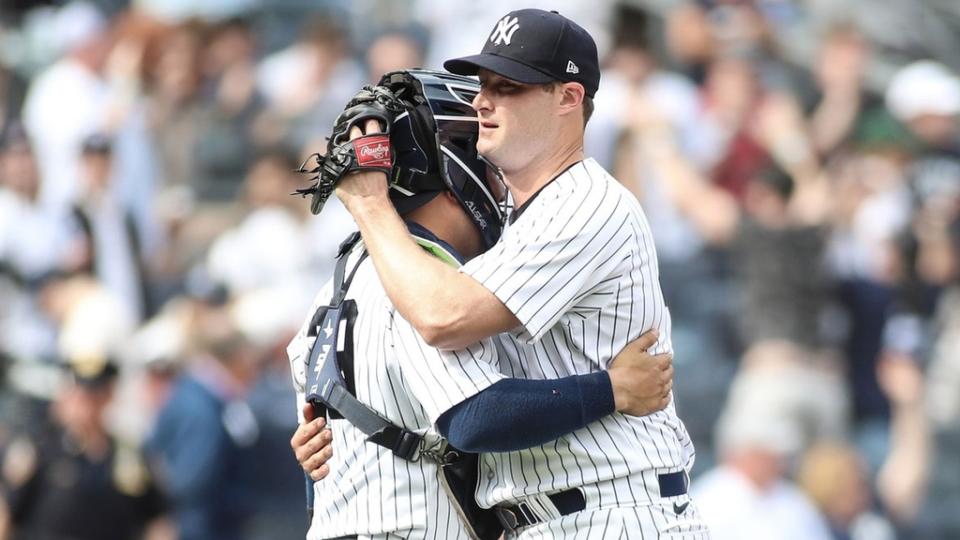
In the top of the seventh inning on Monday, with the tying run at the plate, Yankees manager Aaron Boone made a move that symbolized why his banged-up team is treading water: Reliever Ian Hamiltonand all the organizational work that went into finding and helping him, came into the game.
The Yanks led 5-2 and the Oakland A’s had runners on first and second with no outs. Hamilton opened with a two-seam fastball, a pitch he had never thrown in the big leagues before this year. It induced a fielder’s choice groundout, exactly as it was supposed to do.
Hamilton’s second out came on a 97mph fastball, strike three looking. He then got out of the inning by inducing a swinging strikeout on his slider/change-up, the pitch that makes him special.
All this from a 27-year-old former 11th-round draft pick playing for his sixth organization.
“I’m excited for us,” a grinning Boone said after a 7-2 Yankees win.
When GM Brian Cashman calls the Yankees a “championship-caliber operation” despite their middling record, this is part of what he means. The team’s pro scouts and analysts have made a habit of finding discarded players, minor leaguers, and underachievers from elsewhere.
These players, from Luke Voit to Gio Urshela to Mike Tauchman to Clay Holmes to Lucas Luetge to Jose Trevino and more, help the Yankees survive when their stars are injured. Sometimes, those players become All-Stars.
Hamilton might be the most promising find in a year that also includes outfielders Jake Bauers and Willie Calhoun. He is also evidence of a pitching operation that players say has tightened up this season.
The Yankees’ process for acquiring and helping pitchers works like this: Scouts and/or analysts identify potential acquisitions who are underperforming and would benefit from tweaks to their arsenal. The coaching staff, handed those players, offers advice on what pitches to throw more and which to throw less.
The first significant success story in this area came way back in 2014 when Yankees scouts and analysts saw untapped potential in Arizona Diamondbacks pitcher Brandon McCarthy. The team traded for McCarthy, advised him to throw more cutters, and watched him succeed for the remainder of the season.
Even after that proof-of-concept, it took years for the analysts, coaches and players to hone their communication. Yankee pitchers have sometimes benefited from the data and information presented to them regarding pitch usage and game-planning — and sometimes, they have bristled at it, believing the analytics to be lacking in feel. The Yankees lagged behind their rivals, the Houston Astros, in this respect.

When pitching coach Matt Blake arrived in 2020 with no prior MLB experience in the job, he helped to bridge that gap with a moderate approach and accessible personality. Over the past three seasons, pitchers say, the data on pitch usage slowly became more reflective of their strengths and weaknesses.
This year has brought a strong feeling in the clubhouse that Blake, analyst Zac Fieroh and Trevino have taken the process to new heights. When I spoke to Gerrit Cole for a recent story on his improvements this year, he started his answer by name-checking that trio. Other pitchers have expressed the same feeling: The pitching operation is noticeably sharper in 2023.
In finding Hamilton, the Yankees’ scouts and analysts saw qualities in his pitches, like spin, that made him undervalued. (Cashman played it coy in a text exchange, saying “he had characteristics we liked.” Thank you for the deep dive, Brian.)
Hamilton’s career had been slowed by a car accident that hurt his shoulder and a line drive that caused serious facial injuries in 2021. Prior to this season he had appeared in just 15 big league games and posted a 4.91 ERA. This year he has a 1.35 ERA and 0.85 WHIP for the Yankees. The quality of his stuff suggests that the results are close to sustainable.
Like many of his teammates, Hamilton appreciates working with Blake, Trevino and the analysts.
“It’s a mix between all three of us,” Hamilton said. “Whatever they’re putting down, they have a good feel for the situation.”
The Yankees have helped Cole this year think in terms of where to locate his pitches in the strike zone. Hamilton says that Blake, Trevino and the analysts are doing the same for his three pitches: the four-seam fastball up, the sinker down and the slider away to righties.
“Metrically, it’s kind of a sideways triangle,” Hamilton said. “It looks nice on paper, so if we can just hit those spots we can play with that.”
That’s the kind of talk that comes out of this clubhouse nowadays. For everything else that ails the Yankees, the scouting, data and coaching are working in tandem to squeeze the most from the pitching staff — which, like the rest of the roster, is depleted.
A find like Hamilton certainly helps.